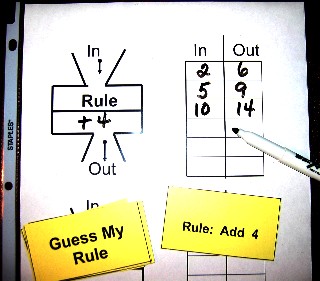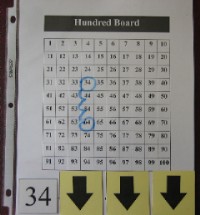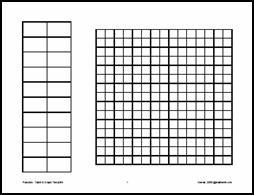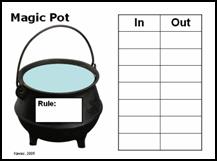
|

|

|

|

|



Using Math Templates
Using math templates during instruction keeps each student actively involved and allows the teacher to informally assess each student's proficiency with the skills and concepts addressed in the day's lesson. Many teachers regularly use whiteboards to have students record answers, write terms, draw pictures, etc. The use of templates in sheet protectors extends this practice and eliminates the time spent drawing diagrams, etc., allowing students more time to demonstrate mathematical proficiency. Teachers who regularly use math templates include planned task items that assess student proficiency. Careful observation of student responses allows teachers to form flexible small groups for additional instruction or enrichment and also better plan for instruction.
- See
 Instructional Strategies for additional active participation strategies using white boards, number cards, etc.
Instructional Strategies for additional active participation strategies using white boards, number cards, etc.
When to Use Templates

Plan to use templates:
- for a quick warm-up activity,
- to check understanding during the lesson,
- as a closure activity at the end of the lesson,
- for small-group instruction
- for test review sessions
- anytime you want to assess student understanding
Once students are accustomed to using the templates, these pages become another tool students may elect to use in problem-solving exercises and should be available in the classroom. Some teachers have developed grade level packets of math templates that are kept in a student math toolkit folder or binder and are available for quick use with dry-erase markers at any point in the math lesson.
Benefits of Using Templates

The regular use of templates:
- makes every student accountable for learning as they may be asked at any point in the lesson to use a template to demonstrate learning of the day's concept or skill
- keeps EVERY student actively involved and constructing meaning for important mathematical terms, concepts and skills.
- allows the teacher to walk around the room, monitor student responses and provide individual help, as needed
- provides quick on-the-go assessment opportunities for teachers to check student understanding
- allows teachers to monitor and adjust the lesson based on students' demonstrated performance using the templates
- provides the basis for forming flexible groups for small-group instruction/reteaching or enrichment
Teachers who regularly use templates report that they are better able to assess student understanding and catch/address conceptual or procedural errors within the same lesson as a result of monitoring student understanding via whiteboards and templates throughout the lesson.
Creating Templates

Student Templates: these are designed to be somewhat generic. Once teachers begin to use templates on a regular basis, they often design their own to best serve the varied needs of students in their classes. All templates on Mathwire.com are available in pdf format for easy printing. Teachers should make a copy for each student and insert each copy in a clear sheet protector so that students can use dry-erase markers and then erase for reuse. Insert two different templates back-to-back for the most efficient use of sheet protectors.
Overhead Templates: Teachers should also make a transparency copy for use on the overhead. If you insert the transparency into a sheet protector, you will also be able to use dry-erase markers and you will find that the transparency lasts longer and is always ready for reuse. Many teachers keep the transparencies in sheet protectors in a binder for quick reference.
Template Library



See  Template Library to check available Mathwire.com templates and download pdf files.
Template Library to check available Mathwire.com templates and download pdf files.
